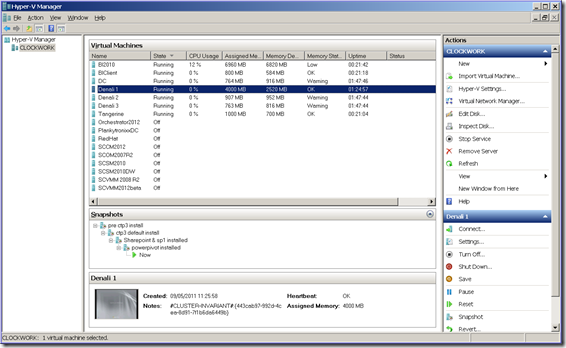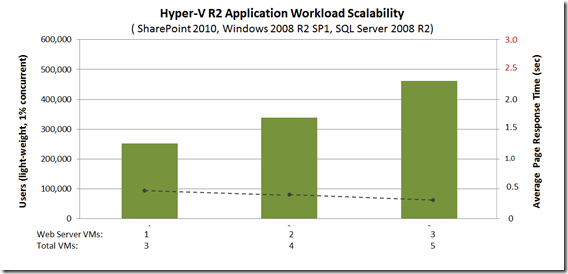Before I get started with SQL Server Denali ctp3
I have spent the last couple of days setting up a demo environment for SQL Server “Denali”, and I thought it might be useful to share some of my experiences over the next few days. Before I get into that a short post about the environment I have which will comprise of 7 x virtual machines (VMs) running on my Dell Precision M6500 aka the Orange Data Centre:
Those VMs work as follows:
- DC - my domain controller, also running DHCP and DNS
- BIClient - a windows 7 VM with all of the SQL Server 2008 R2 tools on such as BI development Studio(BIDS), SQL Server Management Studio (SSMS), PowerPivot, and SharePoint Dashboard Designer.
- Tangerine - a second Windows 7 VM for Denali BI, BIDS, SSMS, PowerPivot, SharePoint Dashboard Designer as well as Visual Studio 2010 Ultimate
- BI2010 - a SQL Server 2008 R2 BI server with SharePoint and all of the BI tools like PerformancePoint, PowerPivot, Reporting Services, Analysis Services and FAST search.
- Denali 1 - a SQL Server Denali BI Server with everything BI in Denali plus SharePoint 2010 sp1, for Crescent, PowerPivot, BISM and the new integrated Reporting Services
- Denali 2 & Denali 3 - two more SQL Server Denali VMs to show the high availability ‘Always On’ capability.
But why not have a VM for SQL Server 2008 R2 and another for Denali?
Speed and Flexibility:
Speed If any of you have tried to use or create an “all in one” VM, complete with a domain controller, Silverlight, SQL Client tools installed it won’t work too well even if you throw 16GB RAM and all your cores at it. You could argue my approach means multiple copies of the operating system (one in each VM) but windows 7 is designed for client stuff like Silverlight and Office , while the domain controller does slow down SQL Server fi they are co-located.I could take this a stage further and put SQL Server in its own VM but that would really only benefit lots of concurrent usage.
Flexibility I have to use my demo laptop for other demos e.g. System Center which requires another 6 VMs (virtual machine manger, operations manager, orchestrator and 2 for service manager). These are joined to the same domain as my BI environment so I can use BI to show System Center or manage BI with System Center, although even my 16Gb SSD only Dell can’t run all of this even with dynamic memory turned on in Windows Server 2008 R2 sp1 Hyper-V.
I wanted to mention this because I see a lot of monolithic VMs which end up being huge and can be very difficult to manage and basically don’t run as well. Of course you might choose not to believe a random Microsoft evangelist but if you look at this graph:
you can see the number of supported users goes up as we add more VMs to the same hardware while response time (the dotted line) drops slightly (Research by the Enterprise Services Group).
However for my demo I am sort of breaking my own guidance as I will just have the one VM for SharePoint and SQL Server Denali. Before I go through my experience of doing that (some of which is whirring away as I type this) I want to use my next post to describe some of the moving parts of SQL Server Denali ctp3 which is available for download here

